No-Till Farmer
Get full access NOW to the most comprehensive, powerful and easy-to-use online resource for no-tillage practices. Just one good idea will pay for your subscription hundreds of times over.

When it comes to any recent discovery about soybean diseases, chances are three researchers have found it. These top-notch no-till researchers have done extensive digging and testing on what no-tillers can do to protect their valuable no-till soybeans from the devastating effects of diseases.
Here’s what you need to know to prevent three soybean headaches.
When it comes to looking at preventative measures to combat the effects of brown stem rot, no one has done more for no-till soybeans than Craig Grau. This University of Wisconsin plant pathologist and his team have made valiant efforts to uncover the cause, effects and prevention of brown stem rot.
What Is It? “Brown stem rot is a fungus that resides in residue,” Grau says. “It is a brown internal discoloration on the stem. Keep in mind that it is in the stem and roots below where the fungus survives—but it does not produce any type of structure or spore that resides in the soil.”
Grau explains brown stem rot can also cause a folial symptom under some conditions. These conditions are more concentrated in cooler, wet growing conditions, commonly found north of Interstate 80.
While no-till may improve soil quality, reduce erosion and preserve conservation, Grau says it isn’t always a bed of roses.
“The two things we’ve been hearing to improve soybean yields are to plant earlier and plant in narrower rows,” he says. “Granted, there are parts of the country where these practices do not…